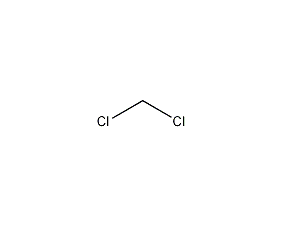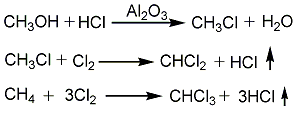
Structural formula
| Business number | 01HZ |
|---|---|
| Molecular formula | CH2Cl2 |
| Molecular weight | 85 |
| label |
dichloromethylene, methylene chloride, Methylene dichloride, Methylene dichloride, DCM |
Numbering system
CAS number:75-09-2
MDL number:MFCD00000881
EINECS number:200-838-9
RTECS number:PA8050000
BRN number:1730800
PubChem number:24856423
Physical property data
1. Properties: colorless and transparent liquid with aromatic odor. [1]
2. Melting point (℃): -95[2]
3. Boiling point (℃): 39.8[3]
4. Relative density (water = 1): 1.33[4]
5. Relative vapor Density (air=1): 2.93[5]
6. Saturated vapor pressure (kPa): 46.5 (20℃)[6]
7. Heat of combustion (kJ/mol): -604.9[7]
8. Critical temperature (℃): 237[8]
9. Critical pressure (MPa): 6.08[9]
10. Octanol/water partition coefficient: 1.25 [10]
11. Flash point (℃): -4[11]
12. Ignition temperature (℃): 556[12]
13. Explosion upper limit (%): 22[13]
14. Explosion lower limit (% ): 14[14]
15. Solubility: Slightly soluble in water, soluble in ethanol and ether. [15]
16. Viscosity (mPa·s, 20ºC): 0.425
17. Relative density (25℃, 4℃): 1.3162
18. Ignition point (ºC): 662
19. Heat of evaporation (KJ/mol, b.p.): 329.5
20. Heat of fusion (KJ/mol) : 4.187
21. Heat of formation (KJ/mol, 25ºC, liquid): 121.54
22. Heat of combustion (KJ/kg, 25ºC, liquid): 558.27
23. Specific heat capacity (KJ/(kg·K), 20ºC): 0.992
24. Electrical conductivity (S/m, 25ºC): 4.3×10-11
25. Vapor pressure (kPa, 0ºC): 19.7
26. Vapor pressure (kPa, 10ºC): 30.6
27. Vapor pressure (kPa, 20ºC): 46.5
28. Vapor pressure (kPa, 30ºC): 68.2
29. Vapor pressure (kPa, 35ºC): 80.00
30. Body Expansion coefficient (K-1, 10~40ºC, liquid): 0.00137
31. Refractive index at room temperature (n25): 1.4213
32. Eccentricity factor: 0.192
33. Lennard-Jones parameter (A): 9.951
34. Lennard-Jones parameter (K): 150.5
35. Solubility parameter (J·cm-3)0.5: 20.378
36.van der Waals area (cm 2·mol-1): 4.990×109
37. van der Waals volume (cm3 sup>·mol-1): 34.710
38. The gas phase standard claims heat (enthalpy) (kJ·mol-1): -95.4
39. Gas phase standard entropy (J·mol-1·K-1): 270.44
40. Gas phase standard generation Free energy (kJ·mol-1): -68.8
41. Gas phase standard hot melt (J·mol-1·K -1): 50.88
42. Liquid phase standard claims heat (enthalpy) (kJ·mol-1): -124.26
43. Liquid phase standard entropy (J·mol-1</Mixed storage. Equipped with the appropriate variety and quantity of fire equipment. The storage area should be equipped with emergency release equipment and suitable containment materials.
Synthesis method
1. Methane chlorination method: After mixing methane, chlorine and circulating gas, they are sent to the reactor for thermal chlorination reaction at 380~400°C. After the gas reaction product is cooled to 70-80°C by the cooler, it is sent to the hydrogen chloride absorption tower, where the hydrogen chloride in the gas product is absorbed and removed with water, and then sent to the alkali washing tower, where it is neutralized with alkali liquid to remove residual hydrochloric acid and free chlorine. The purified gas product is compressed, cooled, and condensed into crude chloride. The crude chloride is sent to the distillation process, and methyl chloride, dichloromethane and chloroform are steamed out through each distillation tower. Except for a part of the non-condensable gas that is vented, the rest is mixed with new materials for recycling. The controlled operating conditions are reaction temperature 400-420°C, ingredient ratio CH4:Cl2=4:1, and products based on methylene chloride can be obtained.

2. Methanol ammoniation method: After the methanol is gasified in the gasifier, it is mixed with the hydrogen chloride separated in the subsequent reaction, and then passed through the catalyst alumina or suboxone chloride or zinc chloride with activated carbon or pumice as the carrier. Phosphoric acid supported on the activated carbon can also be used as the catalyst. , react in a hydrochlorinator at 350°C to generate methyl chloride. The gaseous reaction product is washed with cold water and sodium hydroxide solution in a water washing tower or an alkali washing tower respectively. After removing unreacted methanol and hydrogen chloride, it is sent to the dehydrogenation tower and washed again with sulfuric acid to remove the dimethyl ether and dimethyl ether generated during the reaction. water to obtain methyl chloride. Methyl chloride reacts with chlorine at 410 to 420°C to produce dichloromethane and chloroform, as well as a small amount of carbon tetrachloride. After quenching, it is divided into a liquid phase containing dichloroethane and a gas phase containing uncondensed hydrogen chloride, unreacted methyl chloride, and chlorine. The gas phase is separated to separate hydrogen chloride, methyl chloride and chlorine for recycling. The liquid phase is first sent to the absorption tower and washed with dilute alkali and water to remove carbon tetrachloride, and then sent to the rectification tower to obtain dichloromethane and chloroform respectively through azeotropic distillation and rectification.

3. Methyl chloride chloride Methane chlorination has two processes: photochlorination and thermal chlorination.
Photochlorination is the reaction of methyl chloride and chlorine under 4000kW light. The reaction product is washed with alkali, compressed, condensed, dried and distilled to obtain the finished product.
Thermal chlorination is to mix methyl chloride and chlorine gas according to (2~2.5):1 (mass), and react at a reaction temperature of 400°C and a reaction pressure of 0.2MPa. The reaction product is washed with water, alkali washed, compressed, condensed, dried and distilled to obtain the finished product. ![]()
4. Use industrial methylene chloride as raw material , wash several times with concentrated sulfuric acid 1/8 to 1/10 of the raw material volume until the acid layer is colorless, then wash once with 5% sodium hydroxide solution, the dosage is 1/5 of the raw material volume, and wash twice with water. Then it is dried with anhydrous calcium chloride, the clear liquid is sucked out and then distilled, and the middle fraction is collected to obtain pure methylene chloride.
Purpose
1. In addition to being used in organic synthesis, this product is also widely used as a solvent in cellulose acetate film forming, cellulose triacetate spinning, petroleum dewaxing, aerosols and the production of antibiotics, vitamins and steroids. As well as cleaning, degreasing and release agents for metal surface paint layers.
2. Used for grain fumigation and refrigeration of low-pressure freezers and air-conditioning devices. It is used as an auxiliary blowing agent in the production of polyether urethane foam and as a blowing agent for extruded polysulfone foam.
3. Used as solvent, extraction agent and mutagen. For plant genetic research.
4. It has good dissolving power. It is a low-toxic, non-flammable and low-boiling point solvent among commonly used industrial solvents. It has good dissolving power for many resins, paraffin and fats. Mainly used as paint stripper, petroleum dewaxing solvent, extractant for thermally unstable substances, extractant for lanolin from wool and edible oil from coconut, and solvent for cellulose triacetate film film. It is also widely used in the manufacturing and processing of acetate fiber and vinyl chloride fiber, as well as the manufacturing of fire extinguishing agents, refrigerants, methenamine, etc.
5. Used in the electronics industry. Commonly used as a cleaning and degreasing agent.
6. Because it has an extremely low boiling point and is a flame-retardant solvent, it is widely used. In addition to being used as a cleaning solvent for aircraft engines, precision machinery, etc., it can also be used as a stripper for coatings. It can also be properly mixed with other solvents and used in various industrial cleanings.
7. It is also used as an ethyl ester fiber solvent, dental local anesthetic, refrigerant and fire extinguishing agent. It is a commonly used eluent for chromatographic separation and a common solvent for extraction separation.
8. Used as a solvent in the resin and plastic industry. [33]

 微信扫一扫打赏
微信扫一扫打赏

